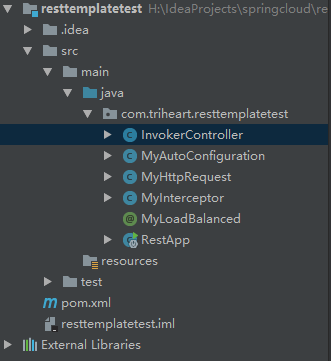本例将模仿拦截器机制,实现一个简单的ReatTemplate,以便更清楚地展示@LoadBalanced以及RestTemplate的原理。
1.@LoadBalanced注解概述
RestTemplate本是spring-web项目中的一个REST客户端,它遵循REST的设计原则,提供简单的API让我们去调用HTTP服务。RestTemplate本身并不具备负载均衡的功能,该类也与SpringCloud没有关系,但是为什么加入@LoadBalanced注解后,一个RestTemplate实例就具有了负载均衡的功能呢?实际上这要得益于RestTemplate的拦截器的功能。在Spring Cloud中,使用@LoadBalanced注解修饰后的RestTemplate,在Spring容器启动时,会为这些被修饰过的RestTemplate添加拦截器,拦截器中使用了LoadBalancerClient来处理请求,LoadBalancerClient本来就是Spring封装的负载均衡客户端,通过这样的间接处理,值得RestTemplate拥有了负载均衡的功能。
2.项目创建及测试
新建一个项目,项目的目录结构如图所示

2.1编写自定义注解以及拦截器
模仿@LoadBalanced注解,编写一个自定义注解,代码清单如下
package com.triheart.resttemplatetest; import org.springframework.beans.factory.annotation.Qualifier; import java.lang.annotation.ElementType; import java.lang.annotation.Retention; import java.lang.annotation.RetentionPolicy; import java.lang.annotation.Target; /** * @author 阿遠 * Date: 2018/8/27 * Time: 21:56 */ @Target({ ElementType.FIELD, ElementType.PARAMETER, ElementType.METHOD }) @Retention(RetentionPolicy.RUNTIME) @Qualifier public @interface MyLoadBalanced { }
MyLoadBalanced 注解中使用了@Qualifier限定注解,接下来编写自定义的拦截器,代码清单如下
package com.triheart.resttemplatetest; import org.springframework.http.HttpRequest; import org.springframework.http.client.ClientHttpRequestExecution; import org.springframework.http.client.ClientHttpRequestInterceptor; import org.springframework.http.client.ClientHttpResponse; import java.io.IOException; /** * 自定义拦截器 * @author 阿遠 * Date: 2018/8/27 * Time: 21:57 */ public class MyInterceptor implements ClientHttpRequestInterceptor { public ClientHttpResponse intercept(HttpRequest request, byte[] body, ClientHttpRequestExecution execution) throws IOException { System.out.println("============= 这是自定义拦截器实现"); System.out.println(" 原来的URI:" + request.getURI()); // 换成新的请求对象(更换URI) MyHttpRequest newRequest = new MyHttpRequest(request); System.out.println(" 拦截后新的URI:" + newRequest.getURI()); return execution.execute(newRequest, body); } }
在自定义拦截器MyInterceptor中,实现了intercept方法,该方法会将原来的HttpRequest对象转换为我们自定义的MyHttpRequest,MyHttpRequest是一个自定义的请求类,实现请求的代码清单如下
package com.triheart.resttemplatetest; import org.springframework.http.HttpHeaders; import org.springframework.http.HttpMethod; import org.springframework.http.HttpRequest; import java.net.URI; /** * 自定义请求类 * @author 阿遠 * Date: 2018/8/27 * Time: 21:59 */ public class MyHttpRequest implements HttpRequest { private HttpRequest sourceRequest; public MyHttpRequest(HttpRequest sourceRequest) { this.sourceRequest = sourceRequest; } public HttpHeaders getHeaders() { return sourceRequest.getHeaders(); } public HttpMethod getMethod() { return sourceRequest.getMethod(); } /** * 将URI转换 */ public URI getURI() { try { URI newUri = new URI("http://localhost:8080/hello"); return newUri; } catch (Exception e) { e.printStackTrace(); } return sourceRequest.getURI(); } }
在MyHttpRequest类中,会将原来请求的URI进行改写,只要使用了这个对象,所有的请求都会被转发到http://localhost:8080/hello这个地址。Spring Cloud在对RestTemplate进行拦截的时候也做了同样的事情,只不过并没有像这里一样固定了URI,而是对“源请求”进行了更灵活的处理。
2.2使用自定义拦截器及注解
编写一个Spring的配置类,在初始化的Bean中为容器中的RestTemplate实例设置自定义拦截器,自动配置类代码清单如下
package com.triheart.resttemplatetest; import org.springframework.beans.factory.SmartInitializingSingleton; import org.springframework.beans.factory.annotation.Autowired; import org.springframework.context.annotation.Bean; import org.springframework.context.annotation.Configuration; import org.springframework.web.client.RestTemplate; import java.util.ArrayList; import java.util.Collections; import java.util.List; /** * @author 阿遠 * Date: 2018/8/27 * Time: 22:01 */ @Configuration public class MyAutoConfiguration { @Autowired(required=false) @MyLoadBalanced private List<RestTemplate> myTemplates = Collections.emptyList(); @Bean public SmartInitializingSingleton myLoadBalancedRestTemplateInitializer() { System.out.println("==== 这个Bean将在容器初始化时创建 ====="); return new SmartInitializingSingleton() { public void afterSingletonsInstantiated() { for(RestTemplate tpl : myTemplates) { // 创建一个自定义的拦截器实例 MyInterceptor mi = new MyInterceptor(); // 获取RestTemplate原来的拦截器 List list = new ArrayList(tpl.getInterceptors()); // 添加到拦截器集合 list.add(mi); // 将新的拦截器集合设置到RestTemplate实例 tpl.setInterceptors(list); } } }; } }
在配置类中定义了RestTemplate实例的集合,并且使用了@MyLoadBalanced以及@Autowired注解进行修饰,@MyLoadBalanced中含有@Qualifier注解。简单的说就是在Spring容器中使用了@MyLoadBalanced修饰的RestTemplate实例,该实例将会被加入到配置类的RestTemplate集合中。在容器初始化时,Spring会调用myLoadBalancedRestTemplateInitializer方法来创建Bean,该Bean在初始化完成后,会遍历RestTemplate集合并为它们设置“自定义拦截器”。
2.3在控制器中使用RestTemplate
控制器代码清单如下
package com.triheart.resttemplatetest; import org.springframework.context.annotation.Bean; import org.springframework.context.annotation.Configuration; import org.springframework.http.MediaType; import org.springframework.web.bind.annotation.RequestMapping; import org.springframework.web.bind.annotation.RequestMethod; import org.springframework.web.bind.annotation.RestController; import org.springframework.web.client.RestTemplate; /** * @author 阿遠 * Date: 2018/8/27 * Time: 22:03 */ @RestController @Configuration public class InvokerController { @Bean @MyLoadBalanced public RestTemplate getMyRestTemplate() { return new RestTemplate(); } /** * 浏览器访问的请求 */ @RequestMapping(value = "/router", method = RequestMethod.GET, produces = MediaType.APPLICATION_JSON_VALUE) public String router() { RestTemplate restTpl = getMyRestTemplate(); // 根据名称来调用服务,这个URI会被拦截器所置换 String json = restTpl.getForObject("http://my-server/hello", String.class); return json; } /** * 最终的请求都会转到这个服务 */ @RequestMapping(value = "/hello", method = RequestMethod.GET) public String hello() { return "Hello World"; } }
注意控制器中的hello方法,前面实现的拦截器会将全部的请求都转到这个服务中。控制器的RestTemplate使用了@MyLoadBalanced注解进行修饰。在控制器中router方法中,使用这个被拦截过的RestTemplate发送请求。打开浏览器,访问http://localhost:8080/router,可以看到如下界面

可以看到,实际上是调用了hello服务。
3.总结
本例展示了RestTemplate的原理,Spring Cloud对RestTemplate的拦截器实现更加复杂,并且在拦截器中使用LoadBalancerClient来实现请求的负载均衡功能。我们在实际环境中,并不需要实现自定义的注解以及拦截器,Spring已经帮我们提供了现成的API。
一般情况下,Spring已经帮我们封装好了Ribbon,我们直接调用RestTemplate等API来访问服务即可实现负载均衡。